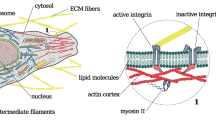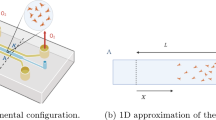Abstract.
In this paper an alternative derivation and interpretation are presented of the classical Keller-Segel model of cell migration due to random motion and chemotaxis. A multiphase modelling approach is used to describe how a population of cells moves through a fluid containing a diffusible chemical to which the cells are attracted. The cells and fluid are viewed as distinct components of a two-phase mixture. The principles of mass and momentum balance are applied to each phase, and appropriate constitutive laws imposed to close the resulting equations. A key assumption here is that the stress in the cell phase is influenced by the concentration of the diffusible chemical.
By restricting attention to one-dimensional cartesian geometry we show how the model reduces to a pair of nonlinear coupled partial differential equations for the cell density and the chemical concentration. These equations may be written in the form of the Patlak-Keller-Segel model, naturally including density-dependent nonlinearities in the cell motility coefficients. There is a direct relationship between the random motility and chemotaxis coefficients, both depending in an inter-related manner on the chemical concentration. We suggest that this may explain why many chemicals appear to stimulate both chemotactic and chemokinetic responses in cell populations.
After specialising our model to describe slime mold we then show how the functional form of the chemical potential that drives cell locomotion influences the ability of the system to generate spatial patterns. The paper concludes with a summary of the key results and a discussion of avenues for future research.
Similar content being viewed by others
References
Advani, S.G.: Flow and rheology in polymeric composites manufacturing. Elsevier, 1994
Alt, W.: Biased random walk models for chemotaxis and related diffusion approximations. J. Math. Biol 9, 147–177 (1980)
Serini, G., Ambrosi, D., Giraudo, E., Gamba, A., Preziosi, L., Bussolini, F.: Modeling the early stages of vascular network assembly. EMBO J. 22, 1771–1779 (2003)
Anderson, A.R.A., Chaplain, M.A.J.: Continuous and discrete mathematical models of tumour-induced angiogenesis. Bull. Math. Biol. 60, 857–899 (1998)
Barker, M.K., Seedhom, B.B.: Articular cartilage deformation under physiological cycling loading. J. Biomech 30, 377–381 (1997)
Bearon, R.N., Pedley, T.J.: Modelling run-and-tumble chemotaxis in a shear flow. Bull. Math. Biol. 62, 775–791 (2000)
Bennet, N.T., Schultz, G.S.: Growth factors and wound healing: Part II role in normal and chronic wound healing. Am. J. Surgery 166, 74–81 (1993)
Boyden, S.V.: The chemotactic effect of mixtures of antibody and antigen on polymorphonuclear leukocytes. J. Exp. Med. 115, 453–466 (1962)
Bray, D.: Cell movements: from molecules to motility. Garland Publishing, 2001
Breward, C.J.W., Byrne, H.M., Lewis, C.E.: The role of cell-cell interactions in a two-phase of solid tumor growth. J. Math. Biol. 45, 125–152 (2002)
Buettner, H.M., Lauffenburger, D.A., Zigmond, S.H.: Measurement of leukocyte motility and chemotaxis parameters with the Millipore filter assay. J. Immunol. Meth. 123, 25–37 (1989)
Byrne, H.M., Cave, G., McElwain, D.L.S.: The effects of chemokinesis on leukocyte locomotion: a new interpretation of experimental results. IMA J. Math. Appl. Med. Biol. 15, 235–256 (1998)
Byrne, H.M., King, J.R., McElwain, D.L.S., Preziosi, L.: A two-phase model of solid tumor growth. Appl. Math. Lett. 16, 567–573 (2003)
Byrne, H.M., Preziosi, L.: Modelling solid tumor growth using the theory of mixtures. IMA J. Math. Appl. Med. Biol. 20, 341–366 (2003)
Dallon, J.C., Othmer, H.G.: A discrete cell model with adaptive signalling for aggregation of Dictyostelium discoideum. Phil. Trans Roy. Soc. B 352, 391–417 (1997)
Drew, D.A., Segel, L.A.: Averaged equations for two-phase flows. Stud. Appl. Math. 50, 205–231 (1971)
Early, A., Abe, T., William, J.: Evidence for positional differentiation of prestalk cells and for a morphogenetic gradient in dictyostelium. Cell 83, 91–99 (1995)
Farina, A., Preziosi, L.: Deformable porous media and composites manufacturing. In: Heterogeneous Media: Micromechanics, Modelling, Methods and Simulations, Markov, M., Preziosi, L. (eds.), Birkhäuser, 2000
Folkman, J., Brem, H.: Angiogenesis and inflammation. In: Inflammation: Basic Principles and Clinical Correlates, Second Edition. Gallin, J.I., Goldstein, I.M. and Dnyderman, R. (eds.), New York, Raven Press, 1992
Fowler, A.C.: Mathematical models in the applied sciences. Cambridge University Press, Cambridge, 1997
Franks, S.J.: Mathematical modelling of tumour growth and stability. PhD thesis, University of Nottingham, England, 2001
Franks, S.J., King, J.R.: Interactions between a uniformly proliferating tumour and its surroundings: uniform material properties. IMA J. Math. Med. Biol., 2003 (submitted)
Fung, Y.C.: Biomechanics: motion, flow, stress and growth. Spinger-Verlag, New York, 1990
Gamba, A., Ambrosi, D., Coniglio, A., de Candia, A., di Talia, S., Giraudo, E., Serini, G., Preziosi, L., Bussolini, F.: Percolation, morphogenesis, and Burgers dynamics in blood vessel formation. Phys. Rev. Lett. 90 (11), 118101 (2003)
Haddox, J.L., Pfister, R.R., Sommers, C.I.: A visual assay for quantitating neutrophil chemotaxis in a collagen gel matrix. J. Immunol. Meth. 141, 41–52 (1991)
Hader, D.P.: Polarotaxis, gravitaxis and vertical phototaxis in the green flagellate, Euglena-gracilis. Arch. Microbiol. 147, 179–183 (1987)
Hill, N.A., Plumpton, L.A.: Control strategies for the polarotactic orientation of the microorganism Euglena gracilis. J. Theor. Biol. 203, 357–365 (2000)
Hillen, T., Painter, K.: Global existence for a parabolic chemotaxis model with prevention of overcrowding. Adv. Appl. Math. 26, 280–301 (2001)
Horstmann, D.: Lyapunov functions and Lp-estimates for a class of reaction-diffusion systems. Coll. Math. 87, 113–127 (2001)
Hou, J.S., Holmes, M.H., Lai, W.M., Mow, V.C.: Boundary conditions at the cartilage-synovial fluid interface for joint lubrication and theoretical verifications. J. Biomech. Eng. 111, 78–87 (1989)
Jackson, T.J., Byrne, H.M.: A mathematical model of tumour encapsulation. Math. Biosci. 180, 307–328 (2002)
Keller, E.F., Segel, L.A.: Initiation of slime mold aggregation viewed as an instability. J. Theor. Biol. 26, 399–415 (1970)
Keller, E.F., Segel, L.A.: Model for chemotaxis. J. Theor. Biol. 30, 225–234 (1971a)
Keller, E.F., Segel, L.A.: Travelling bands of chemotactic bacteria: a theoretical analysis J. Theor. Biol. 30, 235–248 (1971b)
Keller, E.F.: Assessing the Keller-Segel model: how has it fared? In: Biological growth and spread, Jager, W., Rost, H. and Tautu, P. (eds.), Lecture Notes in Biomathematics, 38, Berlin, Springer-Verlag, 1980, pp. 379–387
King, J.R., Franks, S.J.: Mathematical analysis of some multi-dimensional tissue growth models. Eur. J. Appl. Maths., 2003 (in press)
Lai, W.M., Hou, J.S., Mow, V.C.: A triphasic theory for the swelling and deformation behaviours of articular cartilage. J. Biomech. Eng. 113, 245–258 (1991)
Landman, K., Please, C.P.: Tumor dynamics and necrosis: Surface tension and stability. IMA J. Maths. Appl. Med. Biol. 18, 131–158 (2001)
Lega, J., Passot, T.: Hydrodynamics of bacterial colonies: a model. Phys. Rev. E 67(3), 31906 (2003)
Lubkin, S.R., Jackson, T.: Multiphase mechanics of capsule formation in tumours. J. Biomech. Eng. 124, 237–243 (2002)
Mow, V.C., Lai, W.M.: Mechanics of animal joints. Annu. Rev. Fluid Mech. 11, 247–288 (1979)
Murray, J.D.: Mathematical Biology. Springer-Verlag, New York, 1989
Nicholson, C.: Diffusion from an injected volume of a substance in brain tissues with arbitrary volume fraction and tortuosity. Brain Res. 333, 325–329 (1985)
Othmer, H.G., Stevens, A.: Aggregation, blowup and collapse: the ABCs of taxis in reinforced random walks. SIAM J. Appl. Math. 57, 1041–1081 (1997)
Owen, M.R., Sherratt, J.A.: Pattern formation and spatiotemporal irregularity in a model for macrophage-tumour interactions. J. Theor. Biol. 189, 63–80 (1997)
Painter, K.J., Hillen, T.: Volume-filling and quorum-sensing in models for chemosensitive movement. Can. App. Math. Quart., 2003 to appear
Patlak, C.: Random walk with persistence and external bias. Bull. Math. Biophys. 15, 311–338 (1953)
Please, C.P., Pettet, G., McElwain, D.L.S.: A new approach to modelling the formation of necrotic regions in tumors, Appl. Math. Lett. 11, 89–94 (1998)
Primicerio, M., Zaltzman, B.: A free boundary problem arising in chemotaxis. Adv. Math. Sci. Appl. 12, 685–708 (2002)
Primicerio, M., Zaltzman, B.: Free boundary in radial-symmetric chemotaxis Proceedings WASCOM 2001, World Scientific, 2002
Segel, L.A.: A theoretical study of receptor mechanisms in bacterial chemotaxis. SIAM J. Appl. Math. 32, 653–665 (1977)
Sherratt, J.A., Sage, E.H., Murray, J.D.: Chemical Control of Eukaryotic Cell Movement: A New Model. J. Theor. Biol. 162, 23–40 (1993)
Sleeman, B.D., Levine, H.A.: A system of reaction diffusion equations arising in the theory of reinforced random walks. SIAM J. Appl. Math. 57, 683–730 (1997)
Sorek, S., Sideman, S.: A porous medium approach for modelling heart mechanics: Part 1 theory. Math. Biosci. 81, 1–14 (1986)
Spencer, A.J.M.: Deformations of fibre-reinforced materials. Clarendon Press, 1972
Spencer, A.J.M.: Continuum theory of the mechanics of fibre-reinforced composites. Springer Verlag, 1984
Stevens, A.: The derivation of chemotaxis equations as limit dynamics of moderately interacting stochastic many-particle systems. SIAM J. Appl. Math. 61, 183–212 (2000)
Stokes, C.I., Lauffenburger, D.A.: Analysis of the roles of microvessel endothelial cell random motility and chemotaxis in angiogenesis. J. Theor. Biol. 152, 377–403 (1991)
Tyson, R., Lubkin, S.R., Murray, J.D.: Model and analysis of chemotactic bacterial patterns in a liquid medium, J. Math. Biol. 38, 359–375 (1999)
Turing, A.M.: The chemical basis of morphogenesis. Phil. Trans. Roy. Soc. Lond. B237, 37–72 (1952)
Ward, J.P., King, J.R.: Mathematical modelling of avascular-tumour growth. IMA. J. Math. Appl. Med. 14, 39–69 (1997)
Author information
Authors and Affiliations
Corresponding author
Rights and permissions
About this article
Cite this article
Byrne, H., Owen, M. A new interpretation of the Keller-Segel model based on multiphase modelling. J. Math. Biol. 49, 604–626 (2004). https://doi.org/10.1007/s00285-004-0276-4
Received:
Revised:
Published:
Issue Date:
DOI: https://doi.org/10.1007/s00285-004-0276-4




